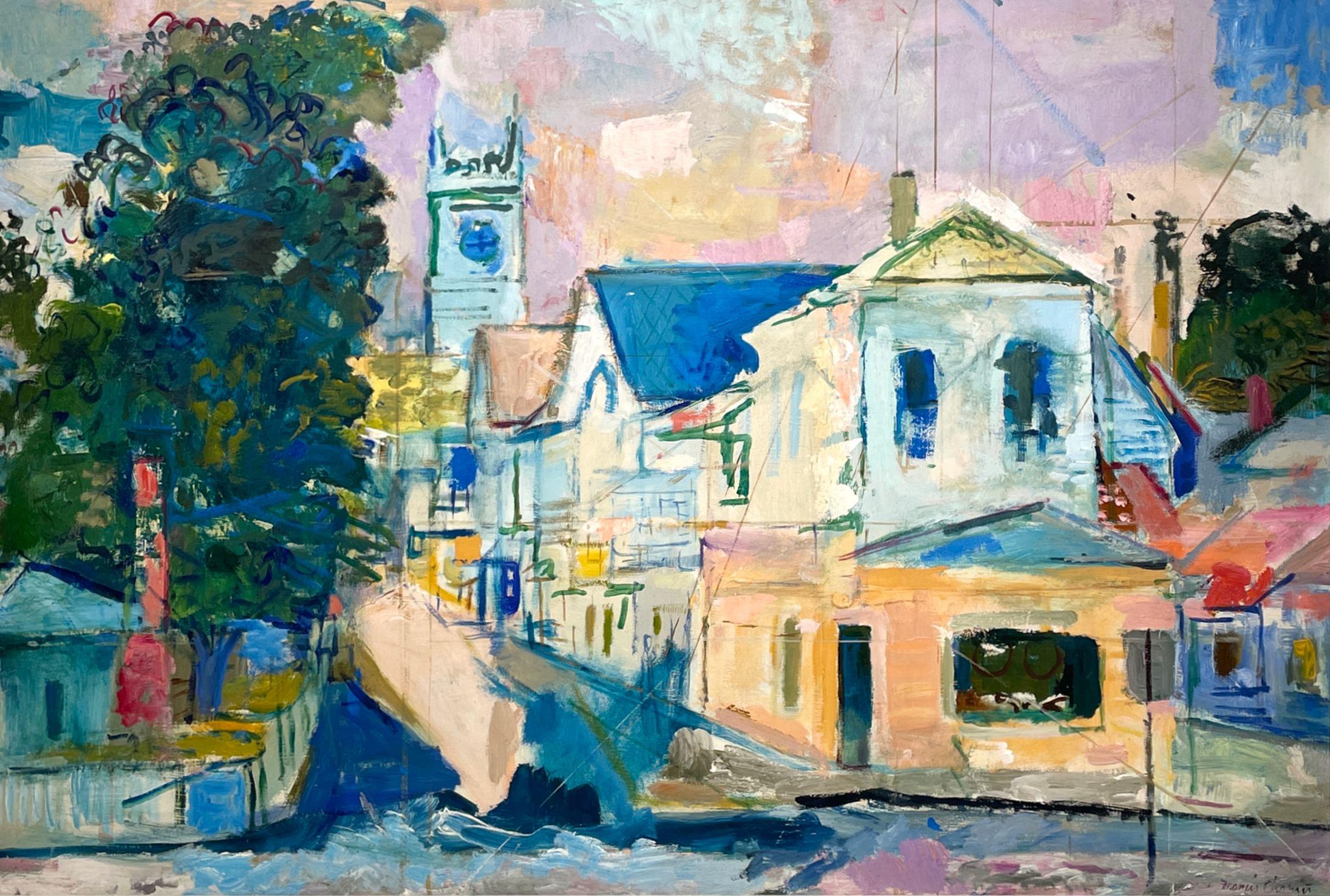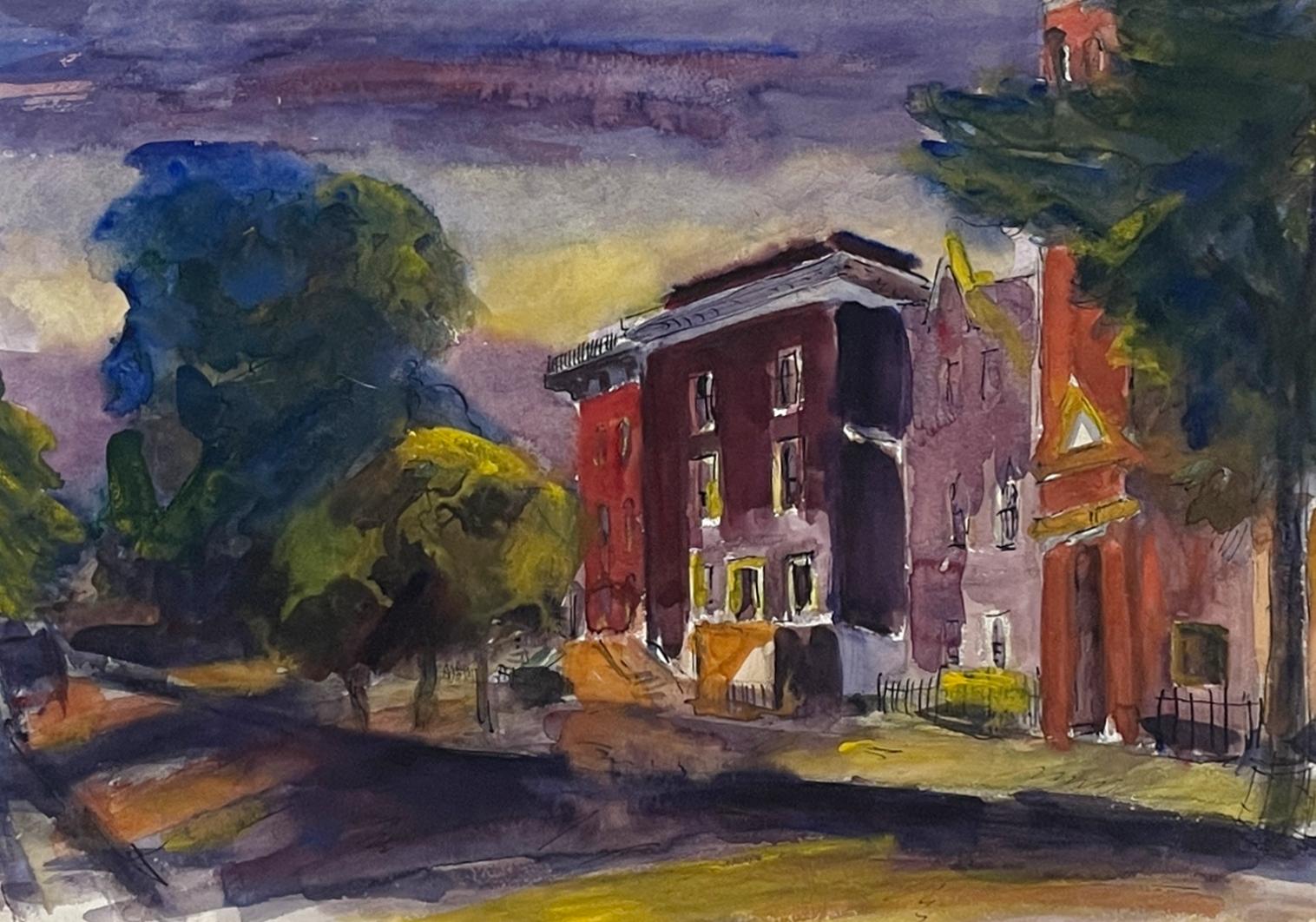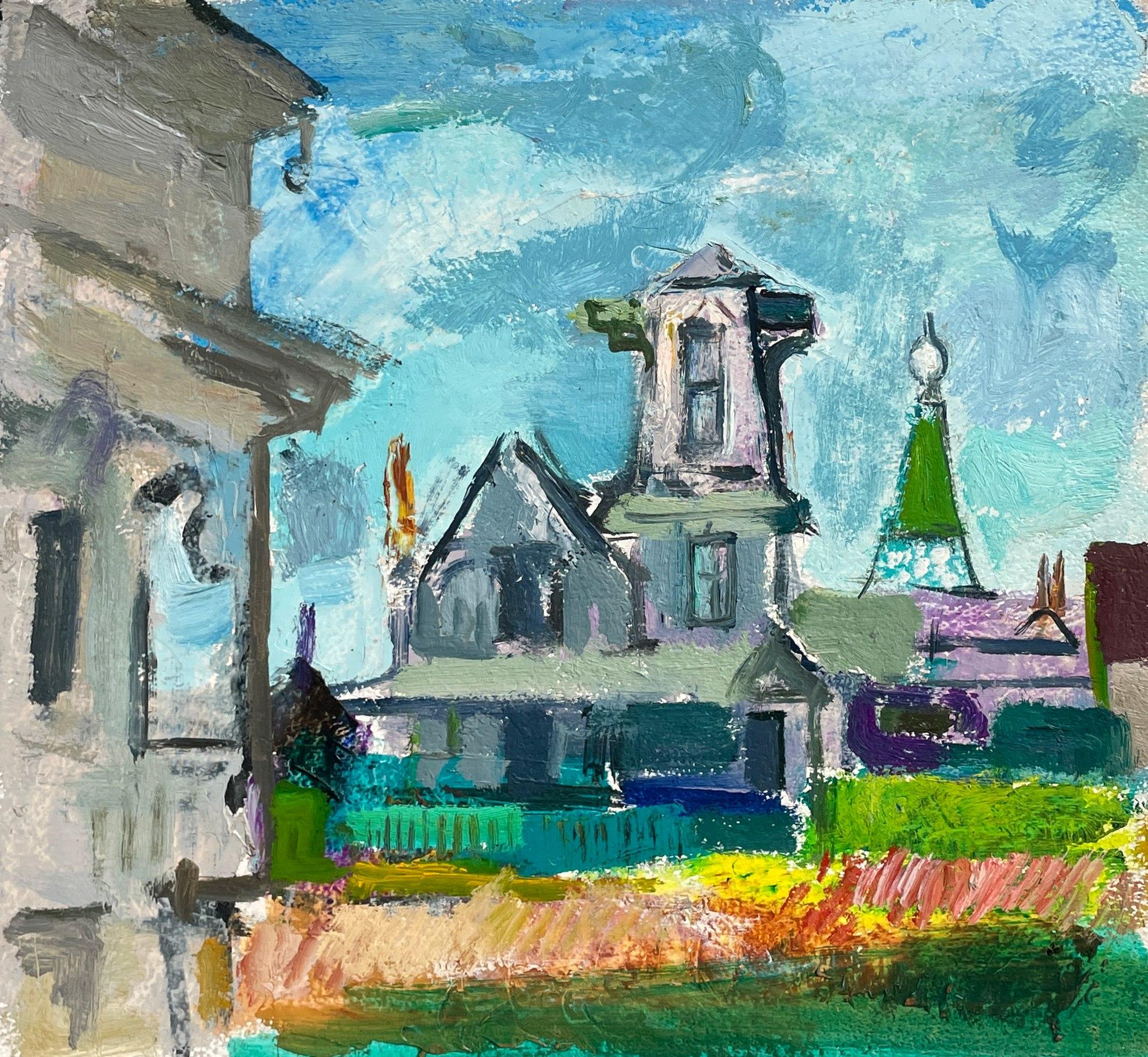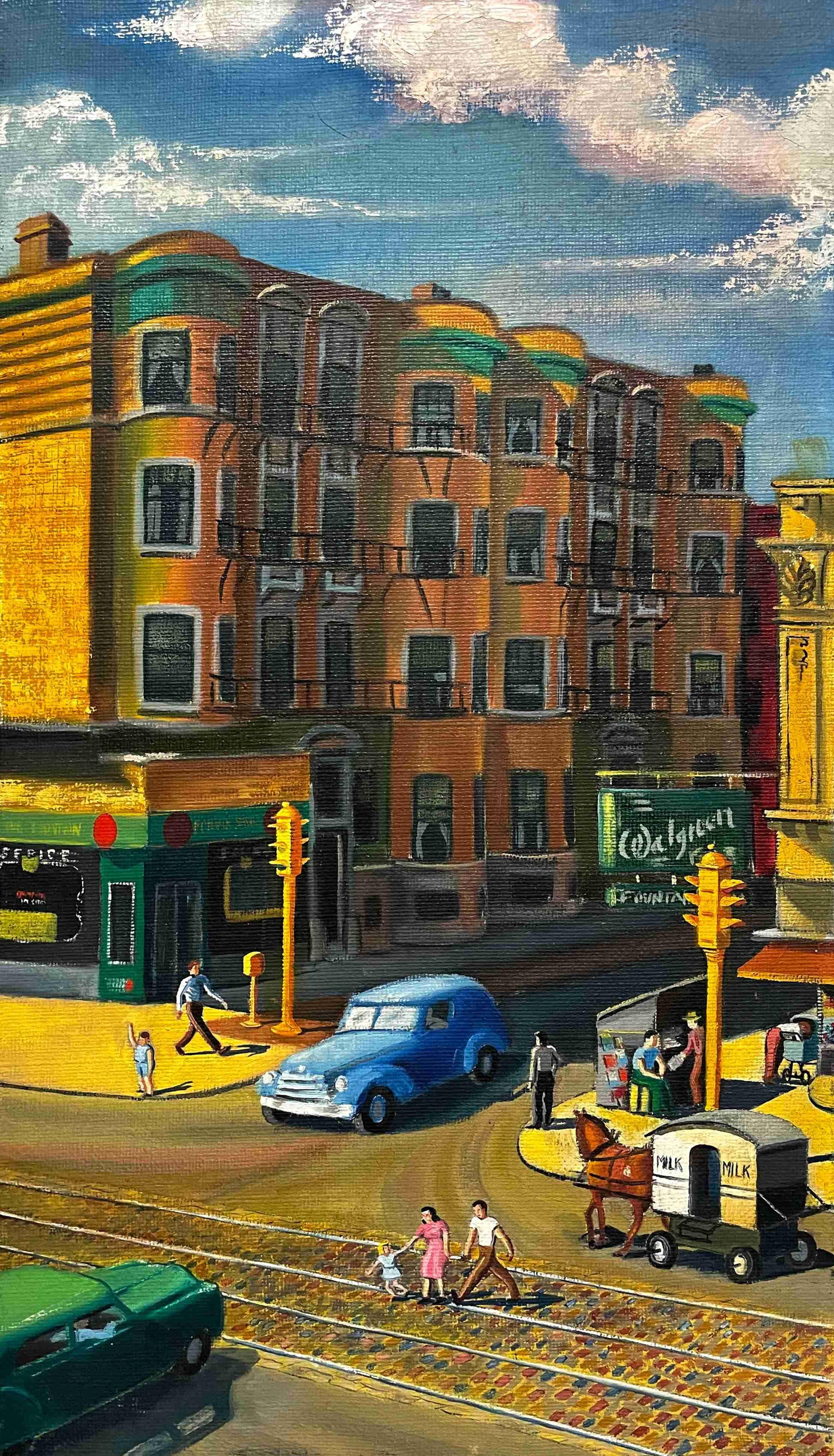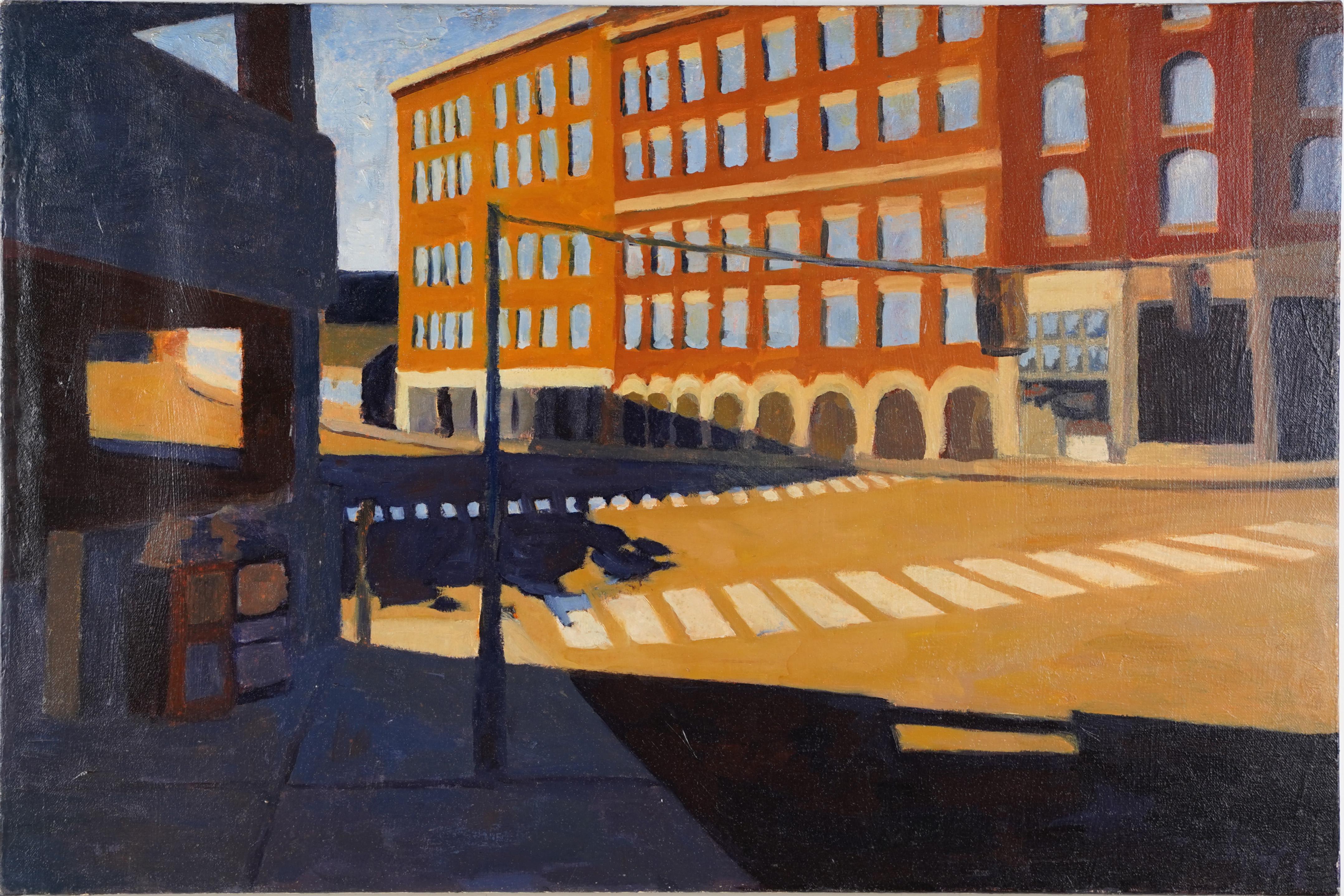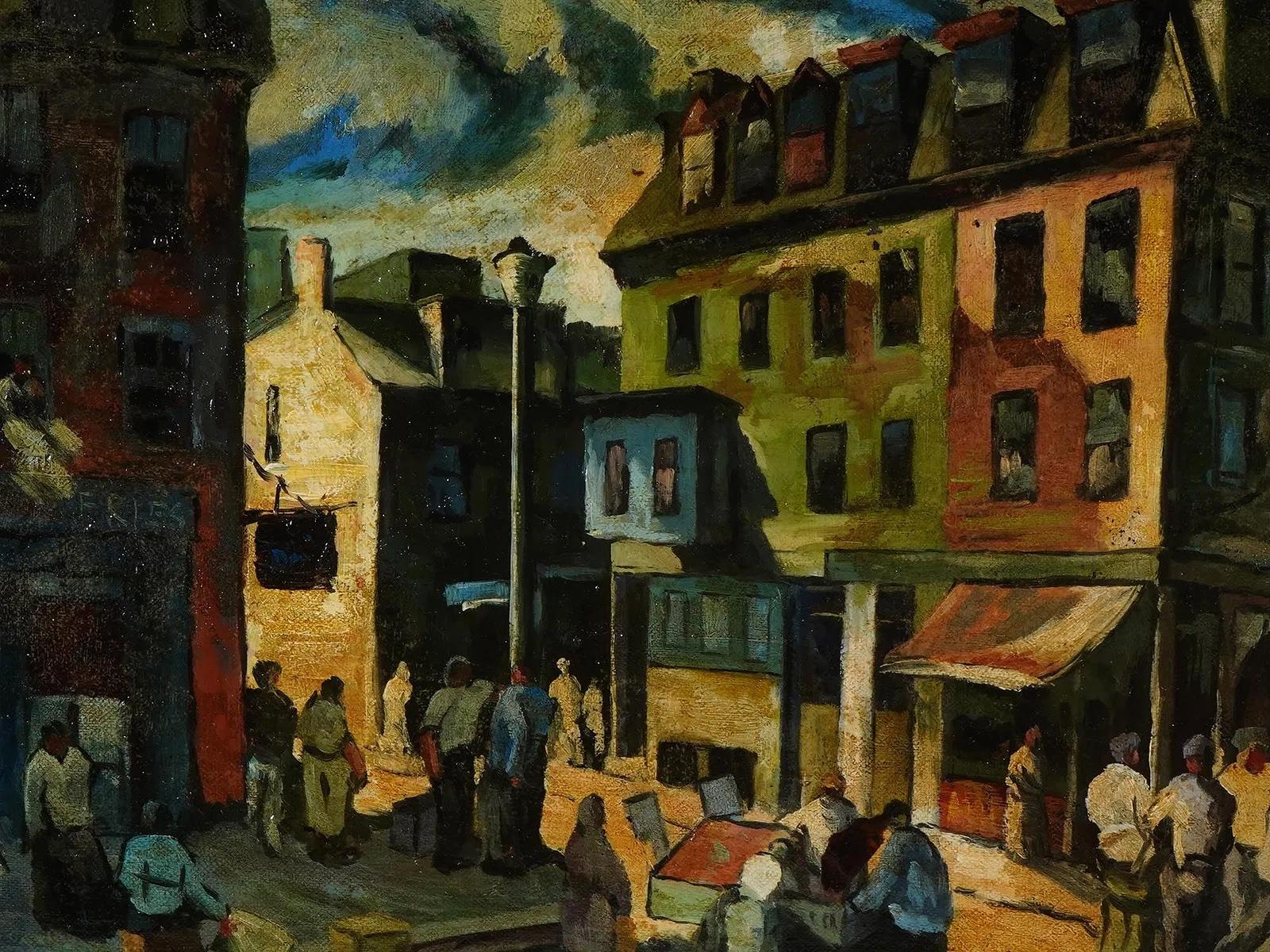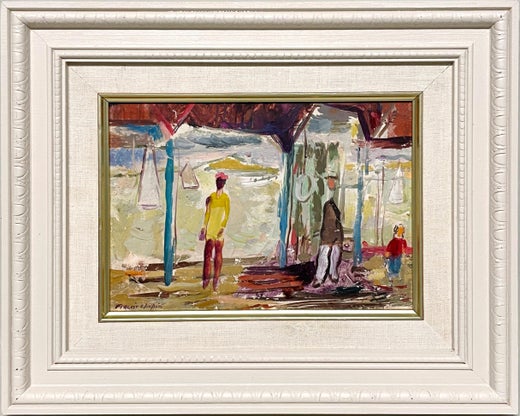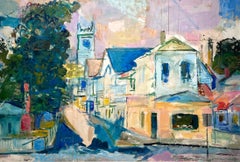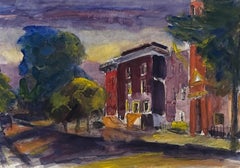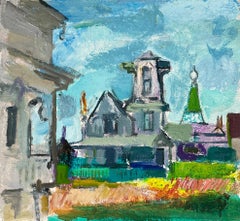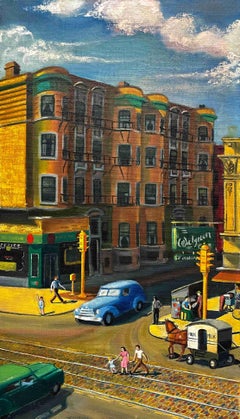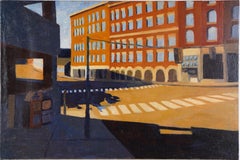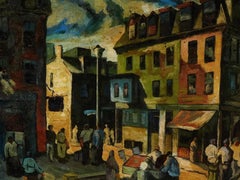Items Similar to A Vibrant, 1930s American Modern Painting, Chicago City Street Scene, Old Town
Want more images or videos?
Request additional images or videos from the seller
1 of 12
Francis ChapinA Vibrant, 1930s American Modern Painting, Chicago City Street Scene, Old TownCirca 1935
Circa 1935
$850
£644.51
€744.41
CA$1,192.60
A$1,328.53
CHF 700.78
MX$16,108.86
NOK 8,914.93
SEK 8,304.82
DKK 5,558.77
About the Item
A Vibrant, 1930s Chicago City Street Scene of the Old Town Neighborhood by Notable Chicago Modern Artist, Francis Chapin (Am. 1899-1965). Depicting a colorful, blustery, autumn view of Chicago's picturesque Old Town neighborhood painted near the artist's studio on Menomoneee Street, with the steeple of St. Michaels Church seen in the background. Oil on Masonite, dating circa 1935. Artwork size: 10” x 10 1/2” (Framed: 11” x 11 1/2”). Estate stamped on reverse. Provenance: Estate of the artist. A gem of a painting!
Francis Chapin, affectionately called the “Dean of Chicago Painters” by his colleagues, was one of the city’s most popular and celebrated painters in his day. Born at the dawn of the 20th Century in Bristolville, Ohio, Chapin graduated from Washington & Jefferson College near Pittsburgh, Pennsylvania before enrolling at the Art Institute of Chicago in 1922. He would set down deep roots at the Art Institute of Chicago, exhibiting there over 31 times between 1926 and 1951. In 1927 Chapin won the prestigious Bryan Lathrop Fellowship from the Art Institute – a prize that funded the artist’s yearlong study trip to Europe. Upon his return to the United States, Chapin decided to remain in Chicago, noting the freedom Chicago artists have in developing independently of the pressure to conform to pre-existing molds (as was experienced by artists in New York, for example). Chapin became a popular instructor at the Art Institute, teaching there from 1929 to 1947 and at the Art Institute’s summer art school in Saugatuck, Michigan (now called Oxbow) between 1934 – 1938 (he was the director of the school from 1941-1945). From 1951 to 1953, Chapin worked as the artist-in-residence at the University of Georgia, Athens, where he painted numerous images of the American South. Chapin’s contemporaries among Chicago’s artists included such luminaries as Ivan Le Lorraine Albright, Edgar Miller, William S. Schwartz and Aaron Bohrod among others.
A prolific painter, Chapin produced numerous works while traveling in Mexico, France, Spain, Saugatuck and Martha’s Vineyard, where he frequently spent his summers and taught at the Old Sculpin Gallery there. Chapin was best recognized for his dynamic and vibrant images of Chicago during the 1930s and 40s. Chapin was a resident of the Old Town neighborhood where he lived and kept his studio on Menomonee Street for many years. Described as a “colorful figure, nearly 6 feet 6 inches tall, and thin, and usually wearing tweeds”, it is easy to imagine Chapin at work observing the busy street life of the city.
In addition to his many exhibitions at the Art Institute of Chicago, Chapin’s work was shown during his lifetime at such institutions as the Pennsylvania Academy of Fine Arts, Philadelphia; the Corcoran Gallery, Washington, D.C.; the National Academy of Design, New York; the Museum of Modern Art, New York; the Whitney Museum of American Art, New York and the Carnegie Institute, Pittsburgh, among others. Francis Chapin’s paintings are represented in the collections the Art Institute of Chicago; the Friedman Collection, Chicago; the Butler Institute of American Art, Youngstown; the Denver Art Museum; the Everson Museum of Art, Syracuse; the Norton Museum of Art, West Palm Beach; the Telfair Museum of Art, Savannah and the Brooklyn Museum of Art, among others.
- Creator:Francis Chapin (1899-1965, American)
- Creation Year:Circa 1935
- Dimensions:Height: 11 in (27.94 cm)Width: 11.5 in (29.21 cm)Depth: 1.25 in (3.18 cm)
- Medium:
- Movement & Style:
- Period:
- Condition:Very good / fine original estate condition. See photos.
- Gallery Location:Chicago, IL
- Reference Number:Seller: #105211stDibs: LU2591216535692
Francis Chapin
Francis Chapin, affectionately called the “Dean of Chicago Painters” by his colleagues, was one of the city’s most popular and celebrated painters in his day. Born at the dawn of the 20th Century in Bristolville, Ohio, Chapin graduated from Washington & Jefferson College near Pittsburgh, Pennsylvania before enrolling at the Art Institute of Chicago in 1922. He would set down deep roots at the Art Institute of Chicago, exhibiting there over 31 times between 1926 and 1951. In 1927 Chapin won the prestigious Bryan Lathrop Fellowship from the Art Institute – a prize that funded the artist’s yearlong study trip to Europe. Upon his return to the United States, Chapin decided to remain in Chicago, noting the freedom Chicago artists have in developing independently of the pressure to conform to pre-existing molds (as was experienced by artists in New York, for example). Chapin became a popular instructor at the Art Institute, teaching there from 1929 to 1947 and at the Art Institute’s summer art school in Saugatuck, Michigan (now called Oxbow) between 1934 – 1938 (he was the director of the school from 1941-1945). A prolific painter, Chapin produced numerous works while traveling in Mexico, France, Spain, Saugatuck and Martha’s Vineyard, where he frequently spent summers and taught at the Old Sculpin Gallery there. Chapin was best recognized for his dynamic and vibrant images of Chicago during the 1930s and 40s. Chapin was a resident of the Old Town neighborhood where he lived and kept his studio on Menomonee Street for many years. Described as a “colorful figure, nearly 6 feet 6 inches tall, and thin, and usually wearing tweeds”, it is easy to imagine Chapin at work observing the busy street life of the city. In addition to his many exhibitions at the Art Institute of Chicago, Chapin’s work was shown during his lifetime at such institutions as the Pennsylvania Academy of Fine Arts, Philadelphia; the Corcoran Gallery, Washington, D.C.; the National Academy of Design, New York; the Museum of Modern Art, New York; the Whitney Museum of American Art, New York and the Carnegie Institute, Pittsburgh, among others. Francis Chapin’s paintings are represented in the collections the Art Institute of Chicago; the Friedman Collection, Chicago; the Butler Institute of American Art, Youngstown; the Denver Art Museum; the Everson Museum of Art, Syracuse; the Norton Museum of Art, West Palm Beach; the Telfair Museum of Art, Savannah and the Brooklyn Museum of Art, among others.
About the Seller
5.0
Recognized Seller
These prestigious sellers are industry leaders and represent the highest echelon for item quality and design.
Established in 2000
1stDibs seller since 2023
75 sales on 1stDibs
Typical response time: 3 hours
- ShippingRetrieving quote...Shipping from: Chicago, IL
- Return Policy
Authenticity Guarantee
In the unlikely event there’s an issue with an item’s authenticity, contact us within 1 year for a full refund. DetailsMoney-Back Guarantee
If your item is not as described, is damaged in transit, or does not arrive, contact us within 7 days for a full refund. Details24-Hour Cancellation
You have a 24-hour grace period in which to reconsider your purchase, with no questions asked.Vetted Professional Sellers
Our world-class sellers must adhere to strict standards for service and quality, maintaining the integrity of our listings.Price-Match Guarantee
If you find that a seller listed the same item for a lower price elsewhere, we’ll match it.Trusted Global Delivery
Our best-in-class carrier network provides specialized shipping options worldwide, including custom delivery.More From This Seller
View AllA Charming 1950s Martha's Vineyard Street Scene Painting by Francis Chapin
By Francis Chapin
Located in Chicago, IL
A large & delightful oil on Masonite, ca. 1950s, Martha's Vineyard street scene painting by artist Francis Chapin. Image size: 24" x 36". Framed size: 27" x 37". In a painted woo...
Category
1950s American Modern Landscape Paintings
Materials
Masonite, Oil
1930s Cheerful Watercolor of a Chicago Street Scene by Constantine Pougialis
Located in Chicago, IL
A 1930s cheerful & colorful watercolor depicting a Chicago Street scene by artist Constantine Pougialis. Image size: 15" x 22". Painting bears its original frame, which measures 21...
Category
1930s American Modern Landscape Drawings and Watercolors
Materials
Paper, Watercolor
Colorful, 1930s American Scene Painting "House with Gable" by Francis Chapin
By Francis Chapin
Located in Chicago, IL
A vibrant 1930s American Scene painting of a sunlit Victorian house by noted American Modern painter Francis Chapin (Am. 1899-1965). Very reminiscent of Edward Hopper's artwork, the...
Category
1930s American Modern Landscape Paintings
Materials
Oil, Board
Fabulous 1950 Painting Titled "47th & Woodlawn Ave in Chicago, ILL" by EC Nieman
Located in Chicago, IL
Make it yours! A fabulous painting titled "47th & Woodlawn Ave in Chicago, ILL" by EC Nieman and dated 1950. It depicts a Walgreen's Drug Store, a horse pulling a milk truck, a new...
Category
1950s American Modern Landscape Paintings
Materials
Canvas, Oil
A Colorful & Dynamic ca. 1950s Painting of Martha’s Vineyard by Francis Chapin
By Francis Chapin
Located in Chicago, IL
A colorful & dynamic ca. 1950s painting of Martha’s Vineyard by notable artist Francis Chapin, featuring The Old Whaler's Church in the background. Artwork size: 12" x 19". Framed...
Category
1950s American Modern Landscape Paintings
Materials
Masonite, Oil
A 1940s American Scene Watercolor of a Chicago Street Scene by Grace Spongberg
Located in Chicago, IL
A 1940s American Scene watercolor depicting a snowy Chicago Street Scene by artist Grace Spongberg. Image size: 12 1/2" x 17". Framed size: 18 1/2" x 22 1/2". This painting come...
Category
1940s American Modern Landscape Drawings and Watercolors
Materials
Paper, Watercolor
You May Also Like
Antique American Modernist Street Scene Vintage Original Oil Painting
Located in Buffalo, NY
Vintage American school modernist cityscape painting. Oil on canvas, wrapped to board. No signature found.
Category
1950s Modern Landscape Paintings
Materials
Canvas, Oil
$1,356 Sale Price
20% Off
Cityscape Mid-20th Century Modern Social Realism American Scene Regionalism WPA
Located in New York, NY
Cityscape Mid-20th Century Modern Social Realism American Scene Regionalism WPA
Samuel Thal (1903 to 1964)
"Cityscene"
12 x 16 inches
Oil on board, c. 1940s
Signed verso
Framed: 19...
Category
1940s American Modern Figurative Paintings
Materials
Board, Oil
"Industrial Cityscape, Chicago" WPA Modernism Mid-Century Cityscape 20th Century
By Aaron Bohrod
Located in New York, NY
"Industrial Cityscape, Chicago" WPA Modernism Mid-Century Cityscape 20th Century
Aaron Bohrod (American 1907 – 1992)
Industrial Cityscape
20 x 16 inches
Oil on board
Signed lower ri...
Category
1930s American Modern Landscape Paintings
Materials
Oil, Board
NYC Cityscape American Scene WPA Modern Realism Mid 20th Century Architectural
By Ernest Fiene
Located in New York, NY
NYC Cityscape American Scene WPA Modern Realism Mid 20th Century Architectural
Ernest Fiene (1894-1965)
Cityscape
36 x 30 inches
Oil on canvas
Signed and dated 1930. lower right
Provenance
Estate of the artist.
ACA Galleries, New York
Exhibited
New York, Frank Rehn Gallery, Changing Old New York, 1931.
New York, ACA Galleries, Ernest Fiene: Art of the City, 1925-1955, May 2-23, 1981, n.p., no. 5.
BIO
Ernest Fiene was born in Elberfeld, Germany in 1894. As a teenager, Fiene immigrated to the United States in 1912. He studied art at the National Academy of Design in New York City from 1914 to 1918, taking day classes with Thomas Maynard and evening classes with Leon Kroll. Fiene continued his studies at the Beaux-Arts Institute of Design in New York from 1916 to 1918, adding classes in printmaking at the Art Students League in 1923.
Fiene began his career as an artist in 1919 with his first exhibition of watercolors at the MacDowell Club arranged by his mentor Robert Henri. In 1923 the Whitney Studio Club mounted a large exhibition of his works. The following year he had an exhibition at the New Gallery in New York, which completely sold out all fifty-two works, including paintings, watercolors, drawings, and etchings. With the proceeds of sales from the New Gallery exhibition, Ernest Fiene and his younger brother Paul, a sculptor, built studios in Woodstock, New York in 1925.
In the early Twenties Ernest Fiene painted mostly landscapes of Woodstock and both the Ramapo and Hudson River Valleys. The first monograph from the Younger Artists Series was published on Fiene in 1922. Published in Woodstock, the series went on to include Alexander Brook, Peggy Bacon, and Yasuo Kuniyoshi. The book reproduced 1 illustration in color and another 27 reproductions in black and white. Around 1925 Fiene became fascinated with the intensity, excitement, and opportunities for color harmonies New York City offered as a subject. His paintings shifted to urban and industrial themes with architecture, industry, and transportation becoming his subjects.
By 1926 Fiene had attracted the dealer Frank K.M. Rehn, who gave him a one-man exhibition that year, which travelled to the Boston Arts Club. C.W. Kraushaar Galleries gave Fiene a one-man exhibition of urban, landscape, portrait, and still life paintings in 1927. Julianna Force, the director of the Whitney Studio Club and first director of the Whitney Museum of American Art, included two of Fiene’s paintings in a fall exhibition in 1928. The Whitney Studio Club showed Fiene’s paintings in a two-man exhibition with Glenn O. Coleman that year and acquired three of Fiene’s paintings. Also in 1928 Fiene became affiliated with Edith Halpert’s Downtown Gallery where he had an exhibition of 20 lithographs in the spring. Fiene sold his house in Woodstock in 1928 to spend more of his time in New York City.
With so many successful exhibitions, Fiene returned to Paris in 1928-29 where he rented Jules Pascin's studio and studied at the Académie de la Grande Chaumière. In France, Fiene painted both landscape and urban subjects developed from ideas influenced by Cubist geometry and the use of flat areas of broad color. Upon returning to New York in 1930, Fiene used this new approach to continue to paint New York skyscraper and waterfront subjects, as well as to begin a series of paintings on changing old New York based on the excavations for Radio City Music Hall and the construction of the Empire State Building. Frank K.M. Rehn Galleries exhibited this series, titled “Changing Old New York,” in 1931. Fiene also has solo exhibitions at Rehn Galleries in 1930 and 1932. Fiene’s oil paintings are exhibited at the Chicago Arts Club in 1930 as well.
Fiene was included in the Museum of Modern Art’s exhibition Painting and Sculpture by Living Americans in December of 1931. Visiting New York, Henri Matisse saw the exhibition and called Fiene’s Razing Buildings, West 49th Street the finest painting he had seen in New York. Fiene had two mural studies from his Mechanical Progress series exhibited at the Museum of Modern Art’s exhibition Murals by American Painters and Photographers in 1932. Fiene sent View from my Window which depicts Fiene working on a lithograph stone while looking out his window to the newly completed Empire State Building to the Carnegie International in 1931. In 1932 Fiene participated in the first Biennial of American Painting at the Whitney Museum and his prints were included in exhibitions at the Downtown Gallery and the Wehye Gallery. In the same year, Fiene was awarded a Guggenheim fellowship to further study mural painting in Florence, Italy.
On his return from Italy in 1933 Fiene re-engaged himself in New York City life and won several public and private mural projects. Fiene resumed his active exhibition schedule, participating in two group exhibitions at the Whitney Museum and a one-man exhibition of recent paintings at the Downtown Gallery in January 1934. In 1933 he purchased a farm in Southbury, Connecticut, which added Connecticut scenes to his landscape subjects. This was also the year Fiene began to spend summers on Monhegan Island, Maine, where he painted seascapes, harbor scenes, and still lifes.
Fiene’s landscape paintings attracted numerous commissions as part of the American Scene movement. Through the fall and winter of 1935-36, Fiene took an extended sketching trip through the urban, industrial, and farming areas of Pennsylvania and West Virginia. Most of the twenty-four Pennsylvania urban and rural paintings...
Category
1930s American Modern Landscape Paintings
Materials
Canvas, Oil
Mid Century French Street Scene Landscape
Located in Soquel, CA
Wonderful French street scene by Ruth Williams Brickner, (American, 1926-2015). Signed "Ruth Brickner" lower right and verso. Williams above lower and Ruth Williams on verso. Circa 1950's. Image size, 16"H x 20.75"L.
Impressionist painter from Los Altos...
Category
1960s American Impressionist Landscape Paintings
Materials
Paper, Gouache
$920 Sale Price
20% Off
1930's Wintry American Modernist Flat Iron NYC street scene
Located in New York, NY
New York City Wintry Street Scene of the Flat Iron Building from the 1930's by Margit De Corini (1897-1982). Oil on Canvas. Signed lower right. D...
Category
1930s American Impressionist Figurative Paintings
Materials
Oil
More Ways To Browse
St Francis
Michael Miller Art
Ivan Summers
Church Steeple
Michael Bryan
J Peters
Dutch Winter Scene Painting
James Sheldon
Jamieson Oil Painting
Painting Blossoming Trees French
Pont Neuf Paris
Regatta Painting
Richard Lewis
Signed A Lefebvre
Snow White Garden
Used Security Gates
William Cook
18th Century Oil Painting Garden
